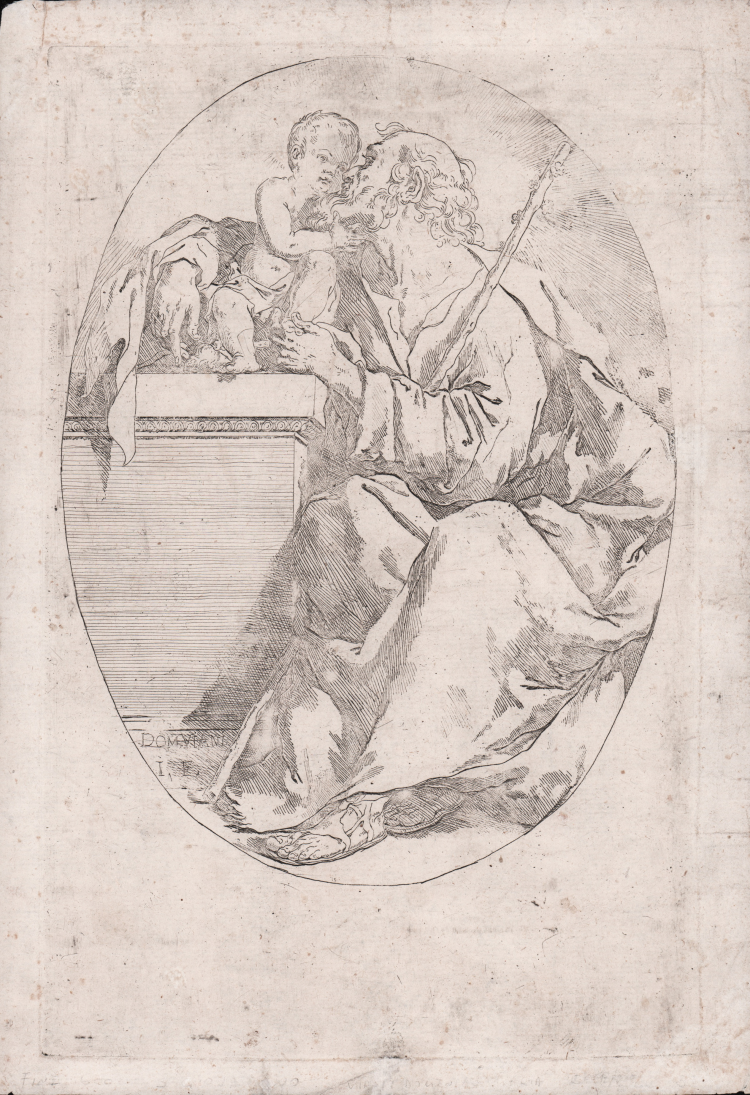



| Reference: | S42044 |
| Author | Domenico Maria Viani |
| Year: | 1690 ca. |
| Measures: | 187 x 290 mm |


| Reference: | S42044 |
| Author | Domenico Maria Viani |
| Year: | 1690 ca. |
| Measures: | 187 x 290 mm |
Etching, 1690 circa, inscribed at base of wall 'Dom Viani I F'.
Exemple in the second state of two described by Bertelà (for Bartsch the only state), with the horizontal hatchings in the pedestal.
Good proof, printed on contemporary laid paper, with margins, in good condition.
An oval composition showing St. Joseph seated with the infant Christ on a low wall pulling his beard, first described by Malaspina: “S. Giuseppe col Bambino. S. Giuseppe seduto in vicinanza di un piedestallo, sul quale sostiene il bambino Gesù, da cui riceve carezze. Il Bambino è a sinistra, e il volto di S. Giuseppe, rivolto pure a sinistra, vedesi quasi di profilo. Sotto il piedestallo sta Dom. Vita. I. F., cioè inventato ed incide. Il tutto è racchiuso in ovale”.
Domenico Maria Viani, was the son of Giovanni Maria, born at Bologna in 1668. After receiving a thorough education in the art from his father, he went to Venice, where he diligently studied the works of the great Venetian masters. Guidalotti, who wrote his life, prefers him to his father. Lanzi says, "few will subscribe to this opinion, he not having attained to that exactness, much less that dignity of design exhibited by his father. He was also inferior to him in the nature, truth, and clearness of his coloring. Still, he possessed a grand character in his outline, a stronger execution, like Guercino's, and more splendid ornaments, like the Venetians. His St. Antony in the church of S. Spirito at Bergamo, in the act of convincing a skeptic by a miracle, is a surprising picture, extolled by Rotari and Tiepolo.” He succeeded his father in the school which he had established at Bologna and instructed several pupils. He executed many works for the churches at Bologna, and the adjacent cities, particularly Bergamo and Pistoia. The principal at Bologna is a series representing the Prophets and Evangelists in the church of the Nativity; and a legendary story of Christ healing a pilgrim, in the church of the Servi. Bartsch describes this unique etching of his depicting St. Joseph with the infant Savior, while Le Blanc and Bertelà also catalog the San Filippo Benizzi, also from one of his subjects. He died at Pistoia in 1711. Some place his birth in 1670, and his death in 1716, but Lanzi and the best authorities, give the dates as above (cf. S. Spooner, A Biographical History of the Arts… (1867), vol. II, p. 1047).
A very rare work.
Bibliografia
Bertelà, Incisori bolognesi ed emiliani del ‘700, nn. 870-871a, II/II; Bartsch, XIX, p. 432, n. 1; Le Blanc, vol. II (3) p. 116 n.2; Malaspina, p. 361
Domenico Maria Viani (Bologna, 11 dicembre 1668 – Pistoia, 1711)
|
Domenico Maria Viani was an Italian painter of the Baroque period. He was born in Bologna, the son of Giovanni Maria Viani, and was educated there under his father, who kept a rival academy to that of Carlo Cignani. For the church of La Natività at Bologna, there is a series of Prophets and Evangelists by him ; for the church of Santo Spirito, Bergamo, he painted a Miracle of St Antony of Padua. He disappeared in Pistoia where he is also thought to have died.
|
Domenico Maria Viani (Bologna, 11 dicembre 1668 – Pistoia, 1711)
|
Domenico Maria Viani was an Italian painter of the Baroque period. He was born in Bologna, the son of Giovanni Maria Viani, and was educated there under his father, who kept a rival academy to that of Carlo Cignani. For the church of La Natività at Bologna, there is a series of Prophets and Evangelists by him ; for the church of Santo Spirito, Bergamo, he painted a Miracle of St Antony of Padua. He disappeared in Pistoia where he is also thought to have died.
|